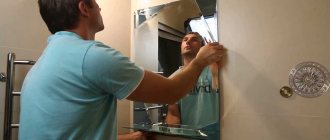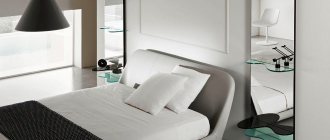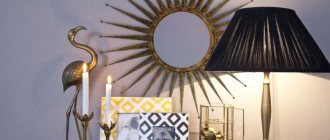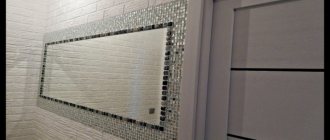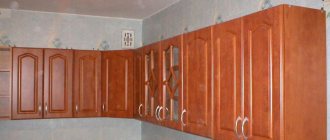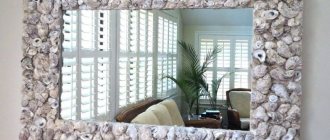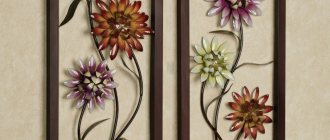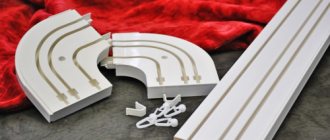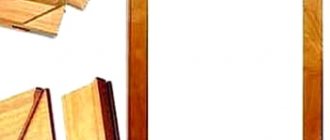To complement the interior with light and make the room more practical, mirrors are often used. They perform several functions simultaneously. A good solution would be to install a mirror on the closet door.
But a natural question arises about how exactly to do this. That is, how to glue a mirror to a cabinet door so that it is held securely and there is no danger of a sudden fall.
It can be either a small cabinet or quite massive furniture.
Features of attaching mirrors to the wall
Framed. Hanging a mirror fixed in a frame is not so difficult. Usually a mirror in a frame is immediately equipped with fasteners, so all you have to do is screw the screws into the wall and hang the mirror.
Even if there are no mounting plates on the frame, installing them is very simple; a picture fastening kit will do.
Important! If the mirror weighs more than 20 kilograms, then you should select reliable fasteners, which consist of 3-4 durable steel plates.
Without frame
This type of mirror is usually chosen if a mirror in a frame does not fit into the design of the room. This mirror is more difficult to secure; below we will examine in detail the main methods of installing it.
Mirror holders and installation methods
If after some time the mirror has to be removed/replaced, it is more convenient to install it on the holders. They are of two types:
- end-to-end;
- non-through (ordinary).
Blind-through mirror holders are installed on a wall or door. Then the edge of the mirror is inserted into them. They can be attached almost flush to the plane of the wall/door, or they can be remote-mounted. In the second option, a gap of 5 mm to several centimeters remains between the wall and the mirror. This saves you if you need to install it on uneven walls.
Installation methods
Glue or sealant. The simplest method of hidden fastening, the only difficulty with this method is choosing a good adhesive composition.
Gluing the mirror sheet is done as follows:
- First, you need to thoroughly degrease the back wall of the canvas; this can be done using gasoline, solvent or isopropyl alcohol. If you have non-woven or paper wallpaper glued to the wall, then you should screw a sheet of plywood onto the wall, and then glue the mirror onto it.
- Prepare wooden blocks for further fixation of the canvas.
- Apply glue to the back side in strips, step back 5 cm from the edge of the canvas and apply sealant around the entire perimeter. It is needed so that the adhesive composition does not lose its basic qualities in the future.
- Installation must be carried out by two people. Press the canvas tightly against the wall, and then install the supporting elements. They can be removed after 2 days, during which time the glue will completely set.
Suspensions
This method is only relevant for small canvases that have holes. In the future, hooks with a cord cling to these holes, and then it is hung on a self-tapping screw in the wall or a special fastening element.
Holders
These holders fit perfectly into any interior, since the main feature is that they have a decorative element (it can be wood, metal or stone).
The disadvantage of these holders is that they are not able to support a massive mirror.
Drilling holes in the sheet
This method is considered labor-intensive, since during the drilling process you can easily split the mirror.
Detailed instructions for drilling the blade:
- Place the mirror on a horizontal surface (for example, on a layout or timber frame).
- Use a permanent marker to mark the locations for the holes.
- Make a small cup without a bottom from plasticine, and then stick it on the mirror where you plan to drill the holes. Fill the cup with water, it is necessary to cool the drill during operation and catch glass dust.
- You can drill a mirror only using a special drill with a diamond tip.
Double sided tape
The method is considered popular for small mirrors. Remember that you can glue the mirror with double-sided tape only on smooth surfaces.
Helpful Tips:
- You can attach the canvas with double-sided tape only if the room temperature is between 10 and 25 Celsius;
- Before starting work, the back side and wall should be wiped of dust and degreased;
- Trace the mirror without tape on the wall, this way you can stick it evenly. Remember that the tape sticks to the wall instantly, so if you glue it crookedly, you won’t be able to move it;
- The adhesive tape should be applied in small strips, the distance between them should be 5-7 cm;
- The protective film from the double-sided tape should be removed before gluing; if removed earlier, the adhesive base may partially lose its basic qualities;
- When you press the mirror against the wall, apply pressure in different places to ensure a good grip on the surface.
Using double-sided tape
The miniature product can easily be fixed to the wall using double-sided tape, on both sides of which a special adhesive composition is applied. The thickness of such tape can vary, but on average it is about 10-20 millimeters.
Installation technology: step-by-step instructions
Even a beginner can handle this installation method, because all the steps to install the product are very simple.
Step 1. You need to attach pieces of tape to a clean mirror sheet. However, you should not cut off large strips. It is better to place small fragments throughout the canvas (as shown in the image).
Glue the tape to the mirror cloth
Step 2. Next, you need to stick the mirror on the wall, using preliminary markings, as in the previous case.
It is necessary to remove the protective layer from the double-sided tape and attach the mirror to the wall
The following advantages of using double-sided tape when installing a mirror can be highlighted:
- it is possible to remove the canvas at any time and secure it in another place;
- Scotch tape is inexpensive and requires very little;
- it has good resistance to temperature changes;
- Using this tape, you can hang a mirror on any surface.
Scotch tape perfectly holds miniature decorative mirrors
According to manufacturers, adhesive tape can be safely used even for fixing medium-sized mirrors. Despite the ease of installation, this is a fairly reliable mounting method.
Among the disadvantages of double-sided tape are the following:
- the mirror will not stick to an uneven wall;
- It is not advisable to abruptly remove the tape from the mirror, otherwise the coating may be damaged.
Nuances of attachment to various surfaces
The base material plays an important role in what fasteners will be used to secure the canvas. In addition, the base depends on what weight of the canvas can be mounted.
Concrete
The concrete wall is characterized by increased strength, so any canvas by weight can be attached to it. Just to create holes you will have to arm yourself with a hammer drill.
You can also use glue for fastening, but before that you will have to prime the wall.
Note! In modern apartments, the technique of assembling mosaics on the wall from mirror fragments is very often used. In this case, the installation of anti-fragmentation film is considered mandatory. It will protect you from fragments when the mirror elements break.
Drywall
GCRs are considered an excellent material for attaching mirrors, since the mirror can be glued directly to drywall. It is worth considering an important point - the weight of the mirror should be up to 25 kg.
PVC panels
Plastic siding is usually mounted on wood or metal sheathing, so a large sheet of siding is mounted on top of the sheathing.
Excess PVC panel material must first be removed.
- You can only install a mirror mosaic of small fragments on the plastic itself; double-sided tape can be used for fastening.
- This method is not suitable for the bathroom, since there is high humidity, and the double-sided tape will most likely come off.
Ceramic or tiles
If you decide to glue a mirror on a tile wall, then first you will need to make holes in the tile. When drilling, you must use a drill with a diamond tip.
There is no need to rush during the work, as a slight displacement of the drill to the side can cause the formation of chips and cracks.
You can also use glue to attach the mirror; you need to make sure in advance that the ceramic tiles are on the same level, because this is necessary for better adhesion to the surface.
We hope you found this article interesting and informative. We wish you good luck!
How to choose a mirror?
In order to choose the highest quality product, it is important to listen to the following recommendations:
- the thickness of the canvas should be more than 6-7 millimeters, then the image will be more realistic;
- the mirror coating must be applied evenly on all sides, in addition, it is important to check that there are no scratches or chips on it;
- the mirror side must be perfectly smooth; the presence of sagging indicates a low-quality product.
Important. It should be remembered that low-quality canvas can easily be damaged during the installation process, so you should not save on such a purchase.
A high-quality mirror should not be too thin
Tips for mirror placement
When making a choice towards one or another method of installing a mirror, you should also remember the rules for placing such products. Of course, not in all cases we manage to hang it exactly where we originally planned. Here the features of the room, and in particular the lack of square meters, are also of great importance.
In small apartments, it is important to allocate the optimal area for each piece of furniture and accessory. Therefore, you should carefully consider the following nuances:
- In a very small room, it is recommended to hang the canvas directly opposite the window. This way it will reflect sunlight, making the room larger for visual perception.
- It is not recommended to mount a mirror in the kitchen near the stove, because due to regular temperature changes it can crack.
- When installing a mirror in a bathroom, its edges must be treated with silicone sealant.
- The mirror in the children's room is covered with a special protective film. This way, even if it breaks, all the pieces will remain in place, so the child will not get hurt.
- If you plan to hang a mirror in a narrow living room, then you can install lamps opposite it - this will also visually enlarge the space.
- The mirror must be hung as level as possible, exactly according to the markings, otherwise the image will be distorted.
- If the wall is too crooked, then before starting installation work it will need to be leveled using putty.
- When choosing a place for installation, it is important to consider that the mirror should not interfere with cabinet doors and other elements.
- It is worth noting that panels that are too large must be fixed to several fasteners of different types at once, which will increase reliability. You can hang lamps opposite the mirror in any room
For some people, installing a mirror with your own hands may seem like a very time-consuming task, but in fact there is nothing difficult about this process. You just need to purchase all the necessary fasteners, accessories and carefully study the instructions.
Rules for caring for mirrors
Photo of attaching a mirror to the wall
What glue to use
Determine exactly the composition with which the mirror will be attached. For this use:
- liquid Nails;
- special glue for mirrors.
To install mirror panels, you must choose a special glue that does not contain components that damage the amalgam (mirror layer). The most popular and frequently used mirror adhesive is Bostik 2750MS. The advantage of this glue is that the wall under it does not need to be primed. The adhesive has good performance characteristics and adhesion and can be used for gluing various surfaces.
In addition to this glue, brands such as SOUDAL, Abro and Tytan have proven themselves well.
When installing a mirror on ceramic tiles in the bathroom, it is better to choose a polymer and moisture-resistant adhesive.
On drywall
There are three ways - use glue, use double-sided tape or install dowels. In the latter case, special plastic butterfly inserts are used. They open up under the drywall when a screw is driven in. In any case, hanging items weighing more than 10 kilograms is not recommended. Drywall is a fragile base, which means that a large mirror will not be held securely. If the structure is heavy, it is better to provide and make a special stand, tripod, or use a floor mirror in a frame without mounting to the wall.
Installation work
You can use the services of a workshop that has the appropriate equipment. When making it yourself, use a drill or a diamond drill.
Installing a mirror on the wall in the bathroom is not very difficult.
It is only important to adhere to a certain algorithm of actions.
First, degrease the surface with alcohol. The hole is made at a distance of at least 30 mm from the edge. The tool is oriented perpendicular to the plane. Drilling is carried out starting at low, then at medium speed.
High tool speeds, pressure, work without cooling are unacceptable!
It is practical to arrange a rim of plasticine around the drilling area and pour water. The finished holes are cleaned with sandpaper.
How to mount a mirror on the wall is a completely solvable task; there are many ways to mount it.
Each has its own characteristics, the choice is made taking into account:
- Rooms (bathroom, living room, hallway - different in humidity levels and air speed);
- To the design (presence of frame, substrate, shelf, hangers);
- Dimensions and weights;
- Presence of holes;
- Material of the room wall;
- D permissibility of drilling with violation of finishing;
- From the falsehood of eliminating defects after removing the product.
A light mirror can be glued to a flat wall using liquid nails, treating the joints with sealant.
How to hang a mirror on the wall and not disturb it is the most important question for a bathroom, where every hole can ruin an expensive finish, but it is of little significance for a concrete, brick or plasterboard partition, on which traces of drilling can be easily and imperceptibly eliminated.
It should be remembered that the glue hardens very quickly, so the mirror must be leveled as quickly as possible.
If the product has holes, it is attached to the drywall with a “butterfly” type device; when hanging on a brick wall, a regular dowel is used. In the absence of drilling, mounting with glue or tape and reliable special fastenings such as staples are equally applicable.
There are many installation conditions and installation methods - there is an option for every situation.
